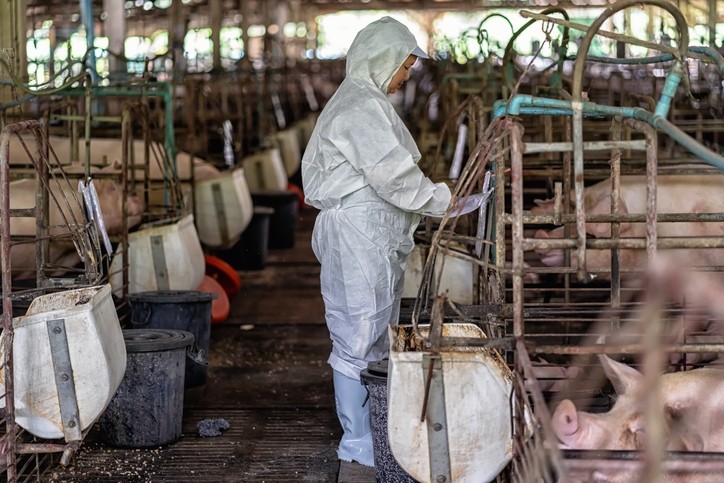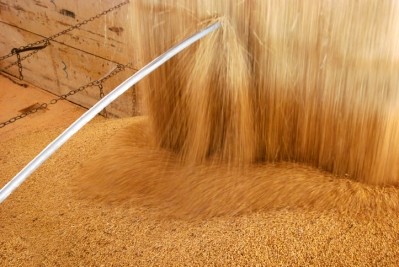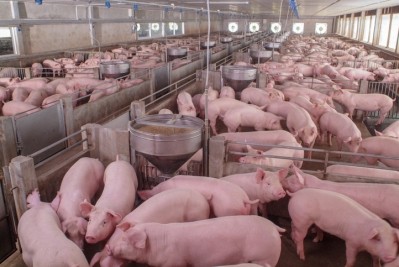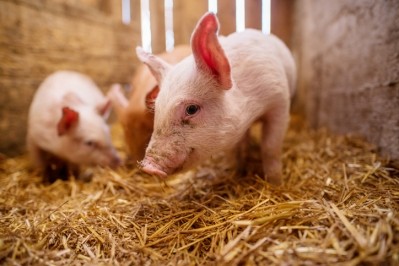Study examines potential role of feed in ASF spread

A team of researchers from Kansas State University examined the minimum and average amounts of African Swine Fever virus (ASFV) that would need to be present in swine feed or water before the animal started to develop the disease.
The group published details of its project in the Center for Disease Control journal, Emerging Infectious Disease.
The rationale behind the work was based on previous research looking at the potential for the porcine epidemic diarrhea virus (PEDV) to survive and be transmitted in feed and feed ingredients, said Megan Niederwerder, corresponding author and assistant professor at Kansas State University.
“The introduction of PEDV into the US in 2013 unveiled the risk of feed and feed ingredients as a potential route for transboundary virus introduction as well as subsequent spread throughout swine producing states,” she added.
“After we realized that feed and feed ingredients were a potential risk factor for transboundary viruses, the next question really was – does feed present a risk for other foreign animal diseases such as African swine fever, classical swine fever, foot and mouth disease, or pseudorabies?” she told FeedNavigator.
During the feeding trial, pigs were exposed to varying amounts of ASFV in liquid or feed and allowed to voluntarily or naturally consume the contaminated product, the researchers said. They were then tracked and checked for the presence of ASF.
The research team found that the minimum infectious dose of ASFV in liquid was 10 or 50% of a tissue culture infectious dose (TCID50). Swine needed to naturally consume a larger amount, 104 TCID50, of virus in feed before they started to display the disease.
Why track ASF in feed, water
Previously, the group explored if ASF would be able to survive for a 30-day period in feed ingredients or complete feeds, said Niederwerder. That study involved varying the humidity and temperature conditions to mimic a transboundary shipment.
“This initial study demonstrated that ASF was broadly stable in a diverse range of feed ingredients and complete feed,” she said.
Previously, the virus was known to be “stable and environmentally resistant” when present in pork products.
“This was the first evidence that ASFV maintained viability in plant-based feed ingredients. Prior to this study, little was known regarding virus stability in feed.
“This was important to understanding the risk of feed for ASFV introduction, however, the infectious dose of ASFV required for transmission through feed remained unknown."
The project looked at tracking the potential for swine to become infected with the disease following the natural consumption of a contaminated complete feed or liquid, she said.
“The goals of the study were to first confirm that it is possible to transmit the virus through consumption of complete feed, and second, to understand the dose that’s necessary to cause infection when these pigs consume contaminated complete feed naturally."
The disease is concerning for industry members for several reasons, including that it is hard to control as there is no vaccine, she said. It also can be transmitted by certain types of ticks and initial clinical signs are not necessarily specific to one swine disease.
The work is part of a larger project to evaluate other foreign animal diseases, including classical swine fever and pseudorabies regarding their potential risk for survival in feed ingredients, transmission through oral routes and mitigation strategies, she said.
“What we’re learning is that viruses such as ASFV can survive in feed and be transmitted through feed, which heightens our awareness, but also heightens the risk of how these viruses could potentially be introduced. At this point, we’re just understanding all of the risk factors for how we need to protect our swine herds with regards to foreign animal disease.”
Feeding trial details
In the feeding trial, 84 pigs were divided into groups of six – where one pig was the negative control and five received a contaminated solid or liquid feed, the researchers said.
Pigs were monitored for clinical signs of the disease twice a day and blood samples were taken on day 0 and 5 post-inoculation, they said. Pigs showing symptoms of the disease were harvested before day 5 and all others were collected on day 5 for blood and tissue samples.
Infection status was established at that time.
Results
The team found that pigs could become infected with the disease following the natural consumption of the contaminated feed or in a liquid medium. No evidence of the disease was found in the 14 negative control pigs.
The probability of infection increased as a larger amount of virus was added to either feed or liquid, they said. At the largest dose tested in liquid, 100% of pigs receiving the oral challenge developed the disease, however, no in-feed dose generated 100% infection.
One of the surprising outcomes of the disease challenge was how small a dose provided in a liquid medium was necessary for pigs to become infected, Niederwerder said. “The lowest dose that we’re confidently able to test in pigs caused infection in almost 40% of the pigs that consumed it – it was extremely infectious when consumed through liquid,” she added.
However, she said, another interesting finding was what could happen according to the modeling performed using the data generated if pigs received the contaminated feed for a longer period. “It was surprising to see how the infection probability goes up in feed even at a low dose due to the infection probability increasing after repeated exposures,” she added.
“What we would anticipate in the field would be that an entire batch of feed would become contaminated from a contaminated ingredient, which would be mixed thoroughly into the feed,” she said. “The pigs would be exposed several times over several days – even though the dose required for infection was higher in feed compared to liquid media, the likelihood of the repeated exposures may make feed an even higher risk.”
In the study, pigs were given 100g of feed with a specific dose of the virus, she said. In a real-world scenario, a pig at a grow-finish facility might have up to 4kg of feed a day so the pig would be exposed to about 40 times the amount used in the trial.
“It’s another important factor to consider for implementing feed biosecurity protocols for the industry,” Niederwerder said. “Whether that be considering where the feed ingredients are imported from, what foreign animal diseases are circulating in that country, [or] what feed ingredients are at risk of becoming contaminated.”
The findings also suggest that mitigation strategies need to be considered, she said. “Whether that be storage time, whether that be heating up ingredients to a certain temperature or whether that be adding a chemical mitigant to reduce the risk of transmission through feed – it all goes back to how do we consider not only pig biosecurity or farm biosecurity, but also start implementing feed biosecurity procedures.”
Source: Emerging Infectious Diseases journal
Title: Infectious Dose of African Swine Fever Virus When Consumed Naturally in Liquid or Feed
Authors: M. Niederwerder, A. Stoian, R. Rowland, S. Dritz, V. Petrovan, L. Constance, J. Gebhardt, M. Olcha, C. Jones, J. Woodworth, Y. Fang, J. Liang, and T. Hefley
DOI: published online ahead of print: DOI: 10.3201/eid2505.181495














